|
|

|
Robbins Medallion Restrikes:
Apollo 13, STS-51L, and STS-107
by Howard C. Weinberger
Every U.S. crewed space flight since Apollo 7 has had a medallion struck by The Robbins Company of Attleboro, MA, as the official astronauts' commemoratives.
Of the 135 missions for which medallions were minted, only three have had their designs revised and restruck after the mission, as the unfortunate result of tragedies: the "successful failure" of Apollo 13, the 1986 STS-51L Challenger accident, and this year's tragic loss of Columbia with the STS-107 crew.
As one of the few official commemoratives for those connected most closely to these missions -- the family, friends and fellow astronauts of the crew -- these three Robbins releases are also exceptional examples for those who seek to collect all 135 medallions.
To understand why these three releases are special, it helps to understand the process by which the medallions are created.
Once NASA authorizes the "design release" of a mission emblem, it is then provided to The Robbins Company. The design is then adapted to create a die cutter sketch for the obverse (front) of the medallion. The design is reproduced as faithfully as possible, given the constraints of working in metal and in three dimensions.
A die cutter sketch for the reverse (back) is also created following a standard template. This includes the crew's names and blank fields labeled simply "Launched" and "Landed" where dates are to be engraved after the flight.
These sketches are then refined with input from the Tool and Die department and final layouts lead to dies being cut. At this point, the Company requests an initial order count from the Astronaut Office, referred to unofficially as the "unfinished, to-be-flown" order.
As a rule, the Astronaut Office "pads" this order with an over-allotment of an additional four silver medallions and one gold medallion to accommodate any last minute requests by the flight crew. The "unfinished, to-be-flown" medallions are produced and shipped to the Astronaut Office where, once final quantities are determined, they are in turn, shipped to the Kennedy Space Center for insertion into the crew's Personal Preference Kits (PPKs).
Sealed in translucent pink anti-static plastic wrap for the duration of the flight, the "unfinished, flown" medallions remain packaged for their return to The Robbins Company after landing. The flown medallions are then engraved and polished.
The surplus unflown medallions are held by The Robbins Company for a later order from the Astronaut Office and certain authorized individuals. This second order is fulfilled using those struck prior to flight and, as needed, striking new medallions.
This same process has been repeated 132 times since 1967. What follows are the three exceptions:
Apollo 13
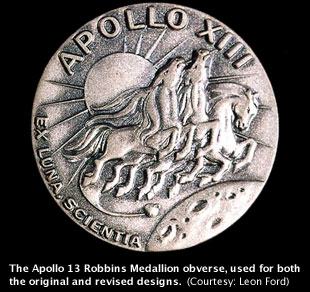
The original medallions designed and struck for Apollo 13 had Thomas Mattingly listed as a prime crew member on their reverse. As he was replaced by Jack Swigert a short three days prior to launch (flight surgeons were concerned Mattingly would develop a case of the German measles having been exposed to them by back-up Charlie Duke), there was no time to strike new medallions. Instead, the Thomas Mattingly-inscribed originals were flown.
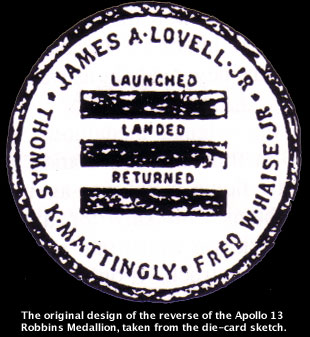
In addition, as Apollo 13 was expected to mark the third manned lunar landing, the original medallions also had a third raised field on their reverse for engraving the date of touchdown on the Moon.
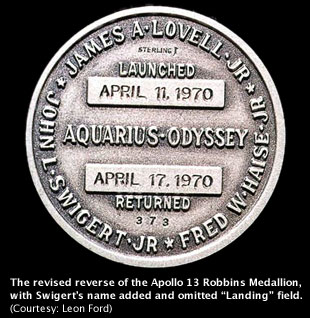
Upon their safe return to Earth, it is believed that all of the flown and unflown medallions were melted down to produce a revised version with Swigert's name added and without a field for the landing date. The possibility cannot be ruled out however, that a few of the "Mattingly, landed" originals survived.
The official population is 6 gold and 404 silver medallions, with the assumption that all are of the revised design.
Challenger / STS 51-L
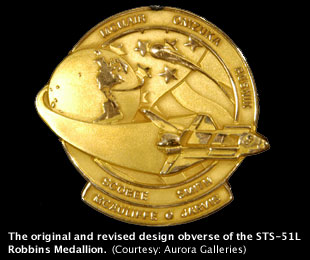
There were Robbins Medallions aboard the flight, but they would all be lost with the explosion of the Space Shuttle Challenger 73 seconds after liftoff.
It is currently unknown whether there were any of the original "unfinished, to-be-flown" medallions that were not flown, or whether they were saved. If past tradition held true, it is possible that at least four of the silver and one of the gold "unfinished, to-be-flown" medallions do exist but no one has yet to report them.
The die-card has also been lost so an image of the original medallion does not exist.
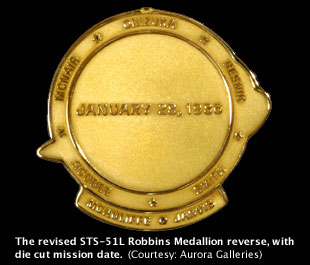
The Robbins Company produced a memorial STS 51-L medallion with the reverse displaying the mission launch date as part of the die itself (rather than engraved). It is believed that the die used for the revised medallions' obverse was the same one used for the original STS 51-L medallions.
The official population is 28 gold and 342 silver, with the assumption that all are of the revised design.
Columbia / STS-107
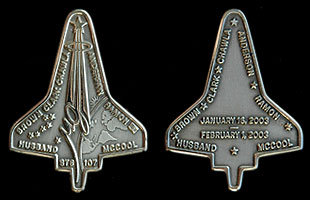
As with STS 51-L, there were Robbins Medallions aboard the flight, but they are all presumed to be destroyed when Columbia disintegrated upon reentry.
There were no gold and 39 silver medallions aboard and one gold and five silver medallions minted but unflown from the Astronaut Office's over-allotment. Presumably, there was a canceled order for a silver medallion to be flown, as there were five medallions instead of the usual four remaining.
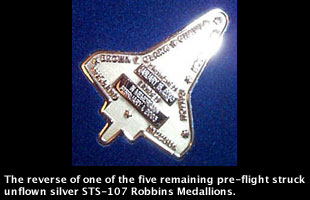
In August 2003, The Robbins Company struck the revised STS-107 medallions. As they had done previously with STS-51L, the reverse displayed the dates as part of the die.
The die used for the revised medallions' front was the same as used for the original medallions.
There were 22 gold and 472 silver medallions struck with the revised design. The gold medallions are numbered 1 through 23, and the silver are 40 through 515.
|

© 2022 collectSPACE.com All rights reserved.
Questions? E-mail [email protected]
|
|

|
Feedback: Messages
Howard Weinberger has been a collector for more than 25 years. His collecting interests are many, however space memorabilia and artifacts are one of his greatest passions. Weinberger has been cited as an expert on collecting trends on WJR Radio and has been a contributor to a number of books on collectible toy rings and premiums. His collections have been featured on FOX's "FX: The Collectibles Show" and in "Today's Collector Magazine."
His book, "The Robbins Medallions: Flown Treasure from the Apollo Space Program," is the definitive guide to flown commemoratives.
|

|







